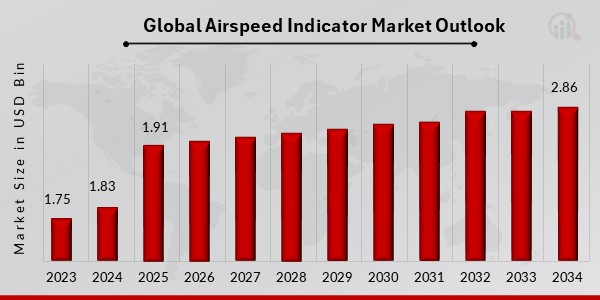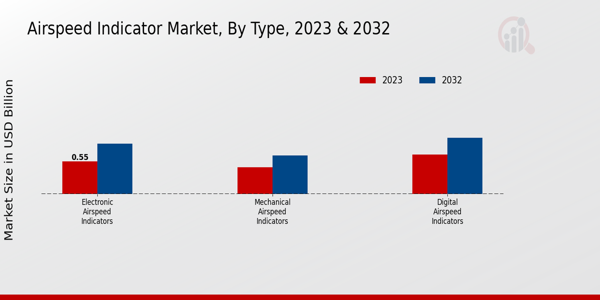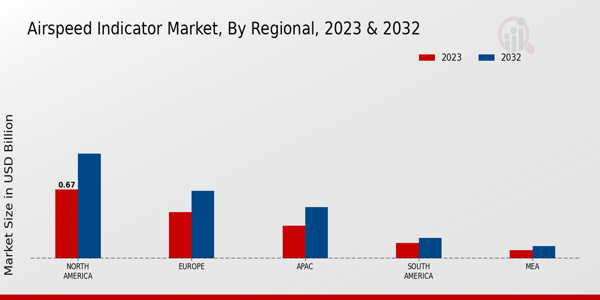Airspeed Indicator Market Overview
Airspeed Indicator Market Size was estimated at 1.83 (USD Billion) in 2024. The Airspeed Indicator Market is expected to grow from 1.91 (USD Billion) in 2025 to 2.86 (USD Billion) by 2034. The Airspeed Indicator Market CAGR (growth rate) is expected to be around 4.56% during the forecast period (2025 - 2034)

Source Primary Research, Secondary Research, MRFR Database and Analyst Review
Key Airspeed Indicator Market Trends Highlighted
Several important variables are driving significant changes in the airspeed indicator market. As companies place a greater emphasis on improving performance and safety, one major market driver is the need for cutting-edge aviation technology.
Additionally, to guarantee effective flight operations, there is a constant demand for trustworthy airspeed indicators due to the growing number of aircraft, both military and commercial.
Strict regulatory requirements for the accuracy of aircraft instruments encourage manufacturers to develop and enhance their product lines, which in turn supports market expansion. The combination of digital displays and sensor systems offers new possibilities for improved functionality, dependability, and user interface as technology advances.
Automation and smart technologies are becoming more prevalent in aviation, according to recent trends. Advanced airspeed indicators that promise more accuracy and efficiency are being adopted due to the increased interest in unmanned aerial vehicles and contemporary avionics systems.
Manufacturers are increasingly focusing on research and development to integrate features like real-time data analytics and connectivity, allowing for improved monitoring and decision-making capabilities.
The trend towards sustainability also prompts innovations in lightweight materials and energy-efficient designs, which can enhance aircraft performance and reduce operational costs. There are substantial opportunities to be explored in emerging markets where the aviation sector is expanding rapidly.
Increased investments in airport infrastructure and fleet modernization create a favorable landscape for airspeed indicator manufacturers. As trade and travel continue to rise, regions with increasing air traffic present a ripe market for new technologies.
Furthermore, partnerships and collaborations between aircraft manufacturers and technology firms can lead to the development of integrated solutions, positioning companies to capture a larger share of the market. The ongoing advancements in aviation will likely encourage new applications and innovations in airspeed indicators, shaping the future of this vital market segment.
Airspeed Indicator Market Drivers
Increasing Demand for Advanced Avionics Systems
The Airspeed Indicator Market is experiencing robust growth driven by the increasing demand for advanced avionics systems. As aviation technology evolves, there is a significant requirement for sophisticated instrumentation that enhances safety and performance during flights.
Airlines and aircraft manufacturers are prioritizing the integration of high-tech systems that not only provide accurate data regarding airspeed but also enhance overall flight monitoring capabilities.
This trend is particularly pronounced in commercial aviation, where the need for compliance with stringent regulatory standards regarding safety and operational efficiency is paramount. Additionally, technological innovations such as digital displays and integrated systems that offer multi-faceted data analysis are becoming more prevalent in aircraft design.
The push for modern avionic solutions is further fueled by the growing trend of air travel among an expanding population, leading to greater pressure on aviation authorities and airlines to leverage better technology for safety and efficiency.
This dynamic landscape of modernization in air travel directly correlates with the growth trajectory of the Airspeed Indicator Market as more sophisticated indicators become essential components of modern aircraft.
As the aerospace industry continues to embrace innovation, the demand for advanced air speed indicators will remain a critical driver of growth in the coming years.
Rise in General Aviation Activities
The rise in general aviation activities is another significant driver for the Airspeed Indicator Market. As more individuals and businesses seek opportunities for private and corporate aviation travel, the demand for quality airspeed indicators has surged. This trend is amplified by the increasing number of private pilot licenses being issued and the growth of small aircraft manufacturing.
Furthermore, the heightened interest in flying for leisure, tourism, and business purposes leads to a greater emphasis on safety and performance, thereby solidifying the importance of accurate air speed measurement.
As general aviation continues to thrive, it acts as a catalyst for innovations in aviation instrumentation, fostering a favorable environment for the airspeed indicator market.
Stringent Regulations and Safety Standards
Stringent regulations and safety standards imposed by aviation authorities significantly drive the Airspeed Indicator Market. Authorities are continually emphasizing the importance of accurate navigation and monitoring systems in aircraft to enhance passenger safety and operational reliability.
Compliance with these evolving safety regulations compels manufacturers to invest in the development and supply of high-quality airspeed indicators that meet or exceed mandated standards.
As the aviation sector faces increasing scrutiny regarding safety measures, ongoing enhancements in technology and products, including airspeed indicators, become essential for industry players to maintain compliance and competitiveness.
Airspeed Indicator Market Segment Insights
Airspeed Indicator Market Type Insights
The Airspeed Indicator Market is poised for steady growth, with various types of airspeed indicators playing pivotal roles.
Among these, Electronic Airspeed Indicators were noteworthy, valued at 0.55 USD Billion in 2023, showcasing their growing acceptance in modern aviation where accuracy and reliability are paramount. This type is expected to expand significantly, reaching a projected 0.85 USD Billion by 2032.
The increased adoption of advanced electronic systems in aircraft is a major driver of this segment's growth, reflecting a shift towards more sophisticated instrumentation for enhancing flight safety and efficiency.
In contrast, Mechanical Airspeed Indicators, which were traditionally dominant, are estimated at 0.45 USD Billion in 2023 and are forecasted to rise to 0.65 USD Billion by 2032. Though they reflect the long-standing expertise in analog flight instrumentation, they are gradually being overshadowed by their electronic counterparts, driven by technological advancements and demand for more precise data.
However, their continued presence is significant due to the reliability and simplicity they offer, particularly in older or smaller aircraft models.
Digital Airspeed Indicators, valued at 0.67 USD Billion in 2023, represented a crucial market segment that dovetails the advances in electronics with user-friendly interfaces. Expected to grow to 0.95 USD Billion by 2032, this type is gaining traction due to its ability to present data clearly and effectively, appealing to both pilots and engineers.
The blend of electronic and digital technologies was crucial in enhancing situational awareness and reducing pilot workload, which are essential features that modern aviation demands.
Collectively, these segments reflected a dynamic landscape in the Airspeed Indicator Market, characterized by evolving consumer preferences and technological innovations that drive market growth across varying aircraft types and applications.
Source Primary Research, Secondary Research, MRFR Database and Analyst Review
Airspeed Indicator Market Application Insights
The market is segmented into key areas such as Commercial Aircraft, Military Aircraft, General Aviation, Drones, and Gliders, each playing a crucial role in the aviation sector. The Commercial Aircraft segment typically holds a significant share, driven by the increasing number of air travelers and the expansion of airline fleets globally.
Military Aircraft also show robust demand due to advancements in defense technologies, while General Aviation is growing steadily as more private individuals pursue flying as a leisure activity.
Drones are witnessing rapid growth, supported by the rise of unmanned aerial vehicles in various industries ranging from delivery services to surveillance. Gliders contribute to a niche but highly specialized segment, focusing on recreational and training purposes, thus showcasing the diversity of applications in the airspeed indicator market.
As the market evolves, the emergence of new technologies and increasing investments in aviation infrastructure present opportunities for further market growth, with the expected trend emphasizing efficiency and safety across all applications.
Airspeed Indicator Market Instrument Cluster Insights
The Airspeed Indicator Market, focusing on the Instrument Cluster segment, is witnessing notable growth dynamics. This segment encompasses various configurations including Standalone Airspeed Indicators, Integrated Cockpit Displays, and Panel Mounted Airspeed Indicators, each playing a vital role in enhancing flight safety and operational efficiency.
Standalone Airspeed Indicators are essential for pilots, offering clear readings and reliability, while Integrated Cockpit Displays provide enhanced functionality with real-time data integration, which is increasingly preferred in modern aviation systems.
The Panel Mounted Airspeed Indicators dominate due to their traditional use and familiar design, making them a staple in both commercial and private aircraft. The market is driven by advancements in technology and increasing air traffic, alongside challenges such as regulatory compliance and integration issues.
Emerging opportunities arise from the growing trend of automation in aviation and the increasing development of smart cockpit solutions, aligning with market growth and evolving user needs.
Understanding the Airspeed Indicator Market segmentation is crucial for stakeholders aiming to capitalize on these trends and navigate the evolving landscape effectively.
Airspeed Indicator Market End Use Insights
The Airspeed Indicator Market is poised for notable growth, with strong contributions from various end-use sectors. The Civil Aviation sector plays a crucial role, driven by the increasing number of air travel passengers and the consequent demand for advanced cockpit instrumentation.
Meanwhile, the Defense sector remains significant as militaries utilize precise instruments for flight operations and pilot training. The Recreational segment has also gained traction thanks to the growing interest in personal and sport aviation.
The diverse applications across these sectors fuel the demand for innovative airspeed indicators and create robust growth opportunities. Overall, the Airspeed Indicator Market statistics reflect an industry responding to evolving aviation technologies, with the Civil Aviation sector expected to continue its dominance due to its expansive market share and demand for safety enhancements.
The segmentation of the Airspeed Indicator Market data underscores the importance of these end-use categories in shaping future market trends and addressing specific needs.
Airspeed Indicator Market Regional Insights
Among the regional landscape, North America held the majority, with a market valuation of 0.67 USD Billion in 2023, projected to reach 1.02 USD Billion by 2032, driven by high aircraft manufacturing and demand for aviation safety technologies. Europe followed as another key player, contributing 0.45 USD Billion in 2023 and advancing to 0.66 USD Billion by 2032, supported by stringent regulations and advancements in aerospace technology.
The APAC market, at 0.32 USD Billion in 2023, is projected to grow to 0.5 USD Billion, reflecting a burgeoning aviation industry and increased passenger traffic within the region.
South America and MEA, while smaller in comparison, showed potential with respective market values of 0.15 USD Billion and 0.08 USD Billion in 2023, illustrating growing investment in aviation infrastructure and modernization efforts.
Overall, the Airspeed Indicator Market statistics underlined a consistent upward trend across regions, with specific hotspots indicating significant opportunities for growth in aviation technology.
Source Primary Research, Secondary Research, MRFR Database and Analyst Review
Airspeed Indicator Market Key Players and Competitive Insights
The Airspeed Indicator Market is characterized by a diverse landscape of competitors, with key players engaged in constant innovation and the enhancement of their product offerings to capture a larger share of the market. As air travel continues to evolve, the demand for precise and reliable air speed indicators remains critical for both commercial and military aviation.
This market is shaped by advancements in technology, regulatory changes, and evolving industry standards, which drive manufacturers to invest heavily in research and development. Additionally, the introduction of digital systems and integration with other avionics components are becoming essential to meet the emerging needs of the aviation sector.
As the market grows, the competitive dynamics are influenced by product differentiation, strategic partnerships, and regional expansion aimed at maximizing market presence.
Honeywell stands out in the Airspeed Indicator Market due to its robust portfolio and commitment to innovation. The company leverages its deep engineering expertise and advanced technology to develop airspeed indicators that offer excellent performance and reliability.
Honeywell's indicators are widely recognized for their accuracy, durability, and ability to withstand varying environmental conditions, making them valuable in both commercial and military applications. The company has established a solid reputation for quality, which is further enhanced by its extensive distribution network and strong customer relationships.
Honeywell focuses on continuous improvement and product innovation, ensuring that its airspeed indicators incorporate the latest technological advancements to meet the needs of modern aircraft systems. This solid foundation positions Honeywell as a leader in the industry, enabling it to capitalize on growth opportunities within the Airspeed Indicator Market.
Rockwell Collins is another key player in the Airspeed Indicator Market, known for its cutting-edge avionics and instrumentation solutions. With a strong emphasis on research and development, Rockwell Collins produces airspeed indicators that integrate seamlessly with a wide range of aircraft systems while offering exceptional reliability and user experience.
The company invests significantly in developing next-generation technologies that enhance the functionality and responsiveness of their indicators, catering to both commercial aviation and defense sectors. Rockwell Collins has built a reputation for delivering high-quality products that meet stringent safety and certification standards, contributing to its strong market presence.
The company's focus on customization and adaptability ensures that its airspeed indicators not only meet current aviation demands but are also prepared for future advancements in the aerospace industry.
This positions Rockwell Collins favorably within the competitive landscape, allowing it to maintain its prominence in the Airspeed Indicator Market.
Key Companies in the Airspeed Indicator Market Include
- Honeywell
- Rockwell Collins
- SAFRAN
- MidContinent Instruments
- Sandel Avionics
- Eaton
- FLIR Systems
- Garmin
- Astronautics
- BendixKing
- L3Harris Technologies
- Thales
- SkyStream
- Aerosonic
- Goodrich
Airspeed Indicator Market Developments
Recent developments in the Airspeed Indicator Market include significant advancements in technology and increasing demand for innovative solutions. Companies like Honeywell, Rockwell Collins, and Garmin have been at the forefront of integrating advanced digital features into airspeed indicators, enhancing accuracy and reliability. MidContinent Instruments and SAFRAN are also focusing on improving their product offerings to meet increased regulatory standards and customer expectations. Current affairs reveal a trend towards multi-functional displays, aligning with evolving aviation industry needs. Furthermore, notable mergers and acquisitions have occurred, including L3Harris Technologies’ strategic expansion through the acquisition of smaller firms to bolster their instrument capabilities, reflecting a competitive landscape focused on technological integration. The market valuation of key players such as Eaton and Thales is showing a positive trajectory, positively influencing overall market dynamics. The emphasis on safety and precision in aviation is driving demand, which in turn impacts production capacity and innovation cycles within these organizations. Companies like FLIR Systems and BendixKing are also adapting to these trends, ensuring they remain relevant in a rapidly evolving market.
- Airspeed Indicator Market Segmentation Insights
- Airspeed Indicator Market Type Outlook
- Electronic Airspeed Indicators
- Mechanical Airspeed Indicators
- Digital Airspeed Indicators
- Airspeed Indicator Market Application Outlook
- Commercial Aircraft
- Military Aircraft
- General Aviation
- Drones
- Gliders
- Airspeed Indicator Market Instrument Cluster Outlook
- Standalone Airspeed Indicators
- Integrated Cockpit Displays
- Panel Mounted Airspeed Indicators
- Airspeed Indicator Market End Use Outlook
- Civil Aviation
- Defense
- Recreational
- Airspeed Indicator Market Regional Outlook
- North America
- Europe
- South America
- Asia Pacific
- Middle East and Africa
Airspeed Indicator Market Report Scope
| Report Attribute/Metric |
Details |
| Market Size 2024 |
1.83(USD Billion) |
| Market Size 2025 |
1.91(USD Billion) |
| Market Size 2034 |
2.86 (USD Billion) |
| Compound Annual Growth Rate (CAGR) |
4.56% (2025 - 2034) |
| Report Coverage |
Revenue Forecast, Competitive Landscape, Growth Factors, and Trends |
| Base Year |
2023 |
| Market Forecast Period |
2025 - 2034 |
| Historical Data |
2019 - 2023 |
| Market Forecast Units |
USD Billion |
| · Key Companies Profiled |
· Honeywell, Rockwell Collins, SAFRAN, MidContinent Instruments, Sandel Avionics, Eaton, FLIR Systems, Garmin, Astronautics, BendixKing, L3Harris Technologies, Thales, SkyStream, Aerosonic, Goodrich |
| · Segments Covered |
· Type, Application, Instrument Cluster, End Use, Regional |
| · Key Market Opportunities |
· Technological advancements in aviation, Rising demand for UAVs, Expansion in emerging markets, Increased emphasis on safety regulations, Integration with digital cockpit systems |
| · Key Market Dynamics |
· Technological advancements, Regulatory frameworks, Increasing aviation activities, Demand for precision instruments, Rising safety standards |
| · Countries Covered |
· North America, Europe, APAC, South America, MEA |
Frequently Asked Questions (FAQ) :
The market is expected to reach approximately 2.5 USD Billion by 2034.
The market is anticipated to grow at a CAGR of 4.56% during the forecast period.
North America is projected to hold the largest market share by reaching around 1.02 USD Billion in 2032.
The market value for Electronic Airspeed Indicators is expected to be approximately 0.85 USD Billion by 2032.
Major players in the market include Honeywell, Rockwell Collins, SAFRAN, and Garmin.
Mechanical Airspeed Indicators are expected to reach a market value of around 0.65 USD Billion by 2032.
In 2023, the Airspeed Indicator Market was valued at approximately 1.67 USD Billion.
The market for Digital Airspeed Indicators is expected to be valued at about 0.95 USD Billion by 2032.
The APAC region is projected to see growth, reaching a market value of approximately 0.5 USD Billion by 2032.
Current conflicts could potentially impact supply chains and demand, influencing market dynamics.

















